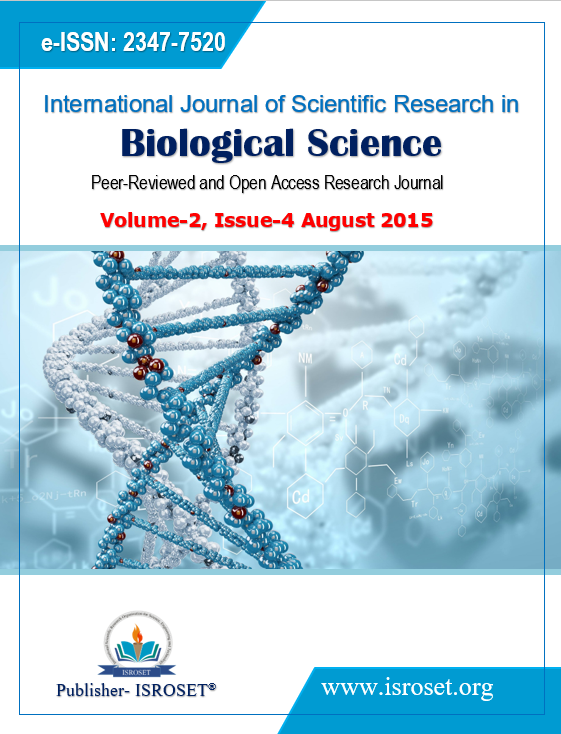Utilisation of Fruit and Vegetable Wastes - An Alternative for the Improvement of the Environment
Keywords:
Waste-management, Probiotic production, Enterococcus faecium, Environment improvementAbstract
The large and increasing amount of waste generated each year in most industrialized countries has raised concerns about its treatment and disposal. A large proportion comes from the waste of fruits and vegetables, turning them into potential pollutant. Microbial technology proves to be a critical tool to combat the problem of organic waste management. Fruit and vegetable wastes have high perishability thus handling and disposal are quite critical to community acceptance. Since they have very high moisture contents, microbial technology, is the most suitable conversion technology to treat fruit and vegetable wastes. Wastes like potato, peas, cauliflower, cabbage, beans, orange, papaya and banana procured from local market served as substrates for the studies. Growth of Enterococcus faecium, a potentially useful probiotic organism, was done on these substrates. Various parameters like pH, temperature, inoculation volume, flask volume and incubation time were optimized. Among the various substrates examined, it was inferred that papaya and banana waste found suitable for the maximum growth. The temperature optimum for the substrates were recorded as 37°C at an optimum of pH 7.0 for both the substrates. Other parameters optimized were inoculation volume 10%, incubation time 24 hrs and flask volume 300ml.Further studies were done on optimization w.r.t the concentration of waste and combination of some nutrient for increasing the growth and 20 % waste along with 1% glucose showed highest growth. Studies have been done on the effect of selected waste materials in general environment. Soil moisture content were analysed for the soil having these dumped wastes and were found to be 41.091%which is 28.748% higher than normal value. The biological studies have shown that when soil contains waste materials having high organic content the bacterial and fungal content of the soil has greatly increased. This study presents a novel-economical approach for the bioconversion of fruit and vegetable wastes for the production of probiotics that is industrially significant. Enormous amount of garbage produced in India is a huge problem in terms of disposal and handling. Therefore, an effort have been made here to utilize fruit and vegetable waste for generation of some useful product........
References
Christian Muller, Anaerobic digestion of biodegradable solid waste in low- and middle-income countries, overview over existing technologies and relevant case studies, Eawag Aquatic Research, Water and Sanitation in Developing Countries (Sandec), Dubendorf; May 2007.
Veeken AHM, Hamminga P, Mingshu Z. Improving sustainability of municipal solid waste management in China by source separated collection and biological treatment of the organic fraction . In: Innovative environmental management & sustainable development – [China]:2005- ISBN 7802092337, Wageningien UR publications.
Bhiday, M.R., 1994. Earth worms in agriculture Indian Farming., 43(12): 31-34
Vimal, O.P. and P.G. Adsule, 1976. Utilisation of fruit and vegetable wastes. Research Industry, 21: 1-6.
Food Agriculture Organization/World Health Organization (FAO/WHO), 2001. Health and nutritional properties of probiotics in food including powder milk with live lactic acid bacteria
Canducci, F., Armuzzi, A., Cremonini, F., Cammarota, G., Bartolozzi, F., Pola, P., Gasbarrini, G., and Gasbarrini A. 2000. A lyophilized and inactivated culture of Lactobacillus acidophilus increases Helicobacter pylori eradication rates. Alimentary Pharmacology and Therapeutics, 14, 1625-1629.
Armuzzi, A., Cremonini, F., Bartolozzi, F., Canducci, F., Candelli, M., Ojetti, V., Cammarota, G., Anti, M., De Lorenzo, A., Pola, P., Gasbarrini. G., and Gasbarrini, A. 2001. The effect of oral administration of Lactobacillus GG on antibiotic-associated gastrointestinal side-effects during Helicobacter pylori eradication therapy. Alimentary Pharmacology and Therapeutics, 15(2), 163-169.
Kailasapathy, K. and Chin, J. 2000. Survival and therapeutic potential of probiotic organisms with reference to Lactobacillus acidophilus and Bifidobacterium spp. Immunology and Cell Biology, 78(1), 80–88.
Franz C.M.A.P., van Belkum M.J., Holzapfel W.H., Abriouel H., Gálvez A. (2007): Diversity of enterococcal bacteriocins and their grouping in a new classification scheme. FEMS Microbiology Reviews, 31, 293–310.
Fuller R (1989): Probiotics in man and animals. A rewiew. Journal of Applied Bacteriology 66, 365–378.
Fleige S, Preißinger W, Meyer HHD, Pfaffl MW (2007): Effect of lactulose on growth perfomance and intestinal morphology of pre-ruminant calves using a milk replacer containing Enterococcus faecium. Animal 1, 367–373.
Samli HE, Senkoylu N, Koc F, Kanter M, Agma A (2007): Effects of Enterococcus faecium and dried whey on broiler performance, gut histomorphology and intestinal microbiota. Archives of Animal Nutrition 61, 42–49.
Vahjen W, Taras D, Simon O (2007): Effect of the probiotic Enterococcus faecium NCIMB10415 on cell Veterinarni Medicina, 55, 2010 (10): 494–503 Original Paper 503 numbers of total Enterococcus spp., E. faecium and E. faecalis in the intestine of piglets. Current Issues in Intestinal Microbiology 8, 1–8.
Downloads
Published
How to Cite
Issue
Section
License

This work is licensed under a Creative Commons Attribution 4.0 International License.
Authors contributing to this journal agree to publish their articles under the Creative Commons Attribution 4.0 International License, allowing third parties to share their work (copy, distribute, transmit) and to adapt it, under the condition that the authors are given credit and that in the event of reuse or distribution, the terms of this license are made clear.







